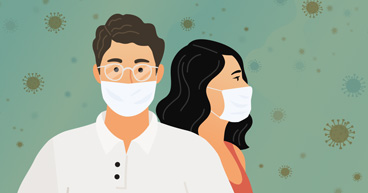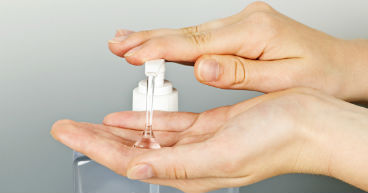
Update: The U.S. Centers for Disease Control and Prevention (CDC) now recommends everyone wear cloth face coverings in public places, such as grocery stores, where social distancing may be difficult. The CDC says these coverings may help slow the spread of COVID-19 by people who may have the virus, but are not yet exhibiting symptoms. The agency suggests making masks from old clothing or other household materials, but it does not recommend using surgical masks or N95 respirators, since those supplies are needed by health care workers.
You’re young and healthy, and you feel great. So, there’s no need to worry about COVID-19, right? After all, you’ve read that the virus is only dangerous to the elderly or those who have health issues, such as cancer. Well, think again. You may not be showing signs or symptoms of the disease, but you may still have it—which means you may be able to infect others, including those in high-risk categories: your uncle recovering from lung cancer, your grandfather with COPD, your mom battling diabetes.
“Symptoms can appear as soon as two days or as long as two weeks after exposure,” says Jeffrey Metts, MD, MPH, Chief of Medicine at our hospital in Atlanta and clinical leader for the COVID-19 task force at Cancer Treatment Centers of America® (CTCA). “The virus can lead to more difficult respiratory complications, including pneumonia, especially in older patients and those with existing illnesses.”
The U.S. Centers for Disease Control and Prevention (CDC) continues to update the list of symptoms COVID-19 patients may experience. Its latest update says common symptoms of the infection include a cough and shortness of breath or at least two of the following:
- Fever
- Chills
- Repeated shaking with chills
- Muscle pain
- Headache
- Sore throat
- New loss of taste or smell
Researchers at the University of Texas (UT), in cooperation with scientists in Europe and Asia, have attempted to measure two key components of how the virus spreads. They are:
- Reproduction number: The number of people infected by an individual case
- Serial interval: The time it takes for symptoms to appear in a person with the virus and one he/she infects
UT researchers concluded that the average serial interval is four days, meaning infected patients could be passing the virus around without knowing it. "The data suggest that this coronavirus may spread like the flu. That means we need to move quickly and aggressively to curb the emerging threat," Lauren Ancel Meyers, an integrative biology professor at UT Austin, told UT News.
How the virus spreads
Consider what happens when you spray a can of air freshener in a room. Aerosol spray hangs in the air for a second before falling on surfaces below. Something similar happens when you cough or sneeze. Droplets of saliva or mucus get sprayed into the air and eventually fall onto a countertop, table, phone or computer keyboard. COVID-19 cells hitch a ride on those droplets, possibly staying active long after someone says “gesundheit.” Your airborne droplets may reach the mouths or noses of people nearby. Or someone may touch droplets on affected surfaces, then touch his or her mouth or nose.
Tips to protect yourself and others
Cancer patients may be especially vulnerable to the virus. Cancers, such as leukemias or lymphomas, and treatments like chemotherapy and radiation therapy may damage immune cells, making it more difficult to fight off other illnesses. That’s why experts advise many patients to self-quarantine and avoid travel and large crowds when possible.
To help prevent the spread of COVID-19:
- Wash your hands frequently with warm water and soap, for at least 20 seconds.
- Avoid touching your mouth, eyes and nose.
- For disinfection, use diluted household bleach solutions, alcohol solutions with at least 70 percent alcohol, and most common household disinfectants registered with the U.S Environmental Protection Agency (EPA). The approved list of products can be found on the EPA website.
- Use a disposable towel or tissue to cover your nose and mouth when you sneeze or cough, then wash your hands.
- Avoid people who are sick—and stay home if you’re sick or experience symptoms like (name them).
- Disinfect countertops, door handles, telephones and other frequently touched objects.
- Be vigilant about avoiding exposure to illnesses such as influenza and measles and require the same of your family and caregivers. (Remember: While vaccines may help curb the spread of those diseases, there is no vaccine for COVID-19.)
Surgical masks or respirators are not recommended to help prevent the spread of the disease. And buying them may create shortages for those who need them, such as medical professionals. “ While there is no harm in wearing a surgical mask, it should not replace more prudent measures such as healthy hygiene to limit exposure and protect others,” Dr. Metts says.
If you are in active treatment and are concerned about how the COVID-19 situation may impact your care, please contact your care team.
Learn more about what cancer patients can do to protect themselves from COVID-19.



